As a rule Farr Vintners sells wines that we know well from famous producers with famous vineyards in famous wine regions. Just now and again, something comes along from off the beaten track that really takes us by surprise...
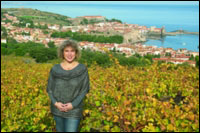
Laetitia Pietri-Clara of Domaine Pietri Giraud with her vines overlooking the Mediterranean.
|
Some time ago, I received a call from a supplier to say that he had discovered a "foudre" (a large barrel) of Banyuls from the 1950 vintage. With 2010 fast approaching, and the prospect of buying a wine that was nearly 60 years of age, this was hard to resist. So, not long afterwards, I found myself driving along the Mediterranean coast of France, a few kilometres north of the border with Spain, on my way to the pretty seaside village of Collioure. The vines around the village grow on terrasses of slate soil on the steep, sunny slopes overlooking the sea, with the Pyranees mountains looming up behind. Here you will find ancient Grenache vines, many of them over one hundred years old. We found the tiny, cramped winery of Domaine Piétri-Geraud in winding streets at the centre of the village. Outside on the verandah there were glass "demi-johns" maturing in the warm sunshine and inside were barrels of various shapes and sizes maturing the local table wine and, more interesting for us, old vintages of the sweet dessert wine, Banyuls. We were told that the Domaine was founded in the 19th century and our host, Laetitia Pietri-Clara, is the fifth generation to tend the 13 hectares of vines.
Laetitia explained that her Grandfather Joseph Geraud had made an exceptional Banyuls in 1950 and decided to keep it as a celebration of the birth of his son (Laetitia's uncle) who sadly died a few years ago. Amazingly, the wine had remained in the same foudre and had never been bottled. Only now - in 2009 - was it decided that the time had come for this ancient nectar to be prepared for its journey away form its birth-place.
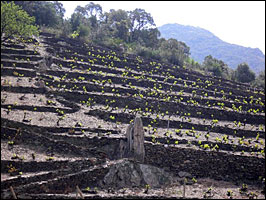
Vines at Domaine Pietri Geraud in the spring.
|
The 1950 harvest in Banyuls, we were told, had produced grapes of great quality and ripeness. As was (and still is) traditional, the fermentation of the must was stopped by "mutage" the adding of a small amount of pure alcohol which brought the alcoholic degree of the wine up to the 16 or 17 degrees that it would have achieved naturally if the yeast had been allowed to do its job of turning the sugar into alcohol. This is what the French call "Vin Doux Naturel" - ie wine where the sweetness comes from the natural sugars of the grapes. The resultant wine was then aged for about 18 months in glass "bonbonnes" outside, before being transferred into its "foudre" and left to slumber, untouched, for nearly 60 years. It was an extraordinary treat to taste a wine straight from the barrel that had been produced 9 years before I was born!
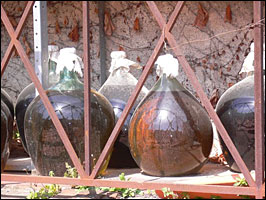
Glass demi-johns of Banyuls maturing in the sun at Domaine Pietri Geraud.
|
The wine was sensational and we quickly agreed to buy all that we could have. There are rich aromas of molasses and treacle on the nose with hints of chocolate, apricot and marzipan. The palate is sweet and full-bodied like a great Malmsey from Madeira. Mouthfilling, round and smooth. It is sweet, yet savoury and full of complexity and concentration. Multi-dimensional, but not heavy or in any way spirity (it has "only" 16 degrees of alcohol compared to typically 22 degrees on a Vintage Port). The myriad flavours reminded us of ripe cherries, figs, dates, raisins and Christmas cake. The lip-smacking finish lasts for minutes. If you have never tasted an old Banyuls, then you are in for a real treat when you try this. If you were born in 1950, it might just bring tears to your eyes!

Domaine Sainte Barbe.
|
We then visited more producers further inland near the city of Perpignan in the appellation of Rivesaltes. Here we found something that will excite any wine lover who was born in the 1960 vintage (a "difficult" year in Bordeaux, Burgundy and the Rhone). At Chateau Sainte Barbe, which dates from the 17th Century, we learnt about Jean Tricoire (born in 1931) who was the father of the current vigneron, Robert Tricoire. Robert's father made "vin doux naturels" in all of the great vintages of the 1950's and 1960's and a foudre of each was kept back for posterity. The method of production here was similar to Banyuls but unlike the 100% Grenache Noir used there, here around one third of the grapes were white - principally Grenache Blanc, Grenache Gris, Maccabeo, Malvoisie and a little Muscat d'Alexandrie.

The bearded Robert Tricoire in the vineyard at Domaine Sainte Barbe.
|
The wine has more of a light terracotta colour with some browning at the rim. The nose reveals notes of nuts, dates, figs and other dried fuits. The palate is not overtly sweet but there is a nutty character and good complexity with hints of coffee, chocolate, raisins and Christmas pudding. There is a zesty kick to it with a little touch of orange peel. Great persistance, life and length for a wine born half a century ago. This would be a great partner for blue cheese or puddings. Not too sweet and not too dry, very good length. A great birthday birthday present for those born in 1960 or a fabulous "winter warmer" for serving at Christmas
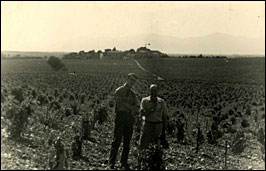
Henri Sisqueille (Father and Son) in the 1930's.
|
The collection of old vintages that we found at Chateau Sisqueille at Canet-en-Roussillon was really remarkable. This property produced great Rivesaltes from the 1920's through to the 1960's. It was founded when Joseph Sisqueille bought the property in 1873 and they still have a small amount remaining (not for sale!) of the first vintage - 1874. The famous vintages here were made by Henri Sisqueille and his son (also called Henri) who died in 1979. All the old vintages here are kept in their original barrels and bottled now and again. We purchased a small stock of the 1940 vintage to celebrate its 70th year. The wines here are made from the three Greanches - noir, blanc and gris. This 1940 has a faded, copper, tawny colour. The nose is full and nutty, reminiscent of a Bual from Madeira. Hints of sweetness. Initially sweet on the palate with good length and richness but then finishes drier. The acidity gives it a freshness than belies its seventy years of age. There are hints of marmalade, figs and a bite of citrus fruit and a touch of candied orange peel. Remarkably lively for a wine of this age. For someone born in 1940 this would be an absolute treat, for the rest of us it still an amazing vinous experience.
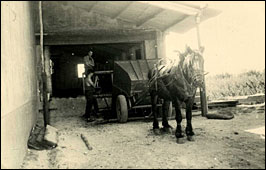
Vintage time at Chateau Sisqueille between the wars.
|
This trip to Banyuls and Rivesaltes gave me an amazing opportunity to sample a taste of history and the collection of old vintages that Farr Vintners has now shipped to the UK allows our customers to sample, at remarkably modest prices, great and authentic wines from the 1920's to the 1970's. We would be happy to make up mixed cases (of 6 or 12) of any of the 10 vintages that we currently have available.